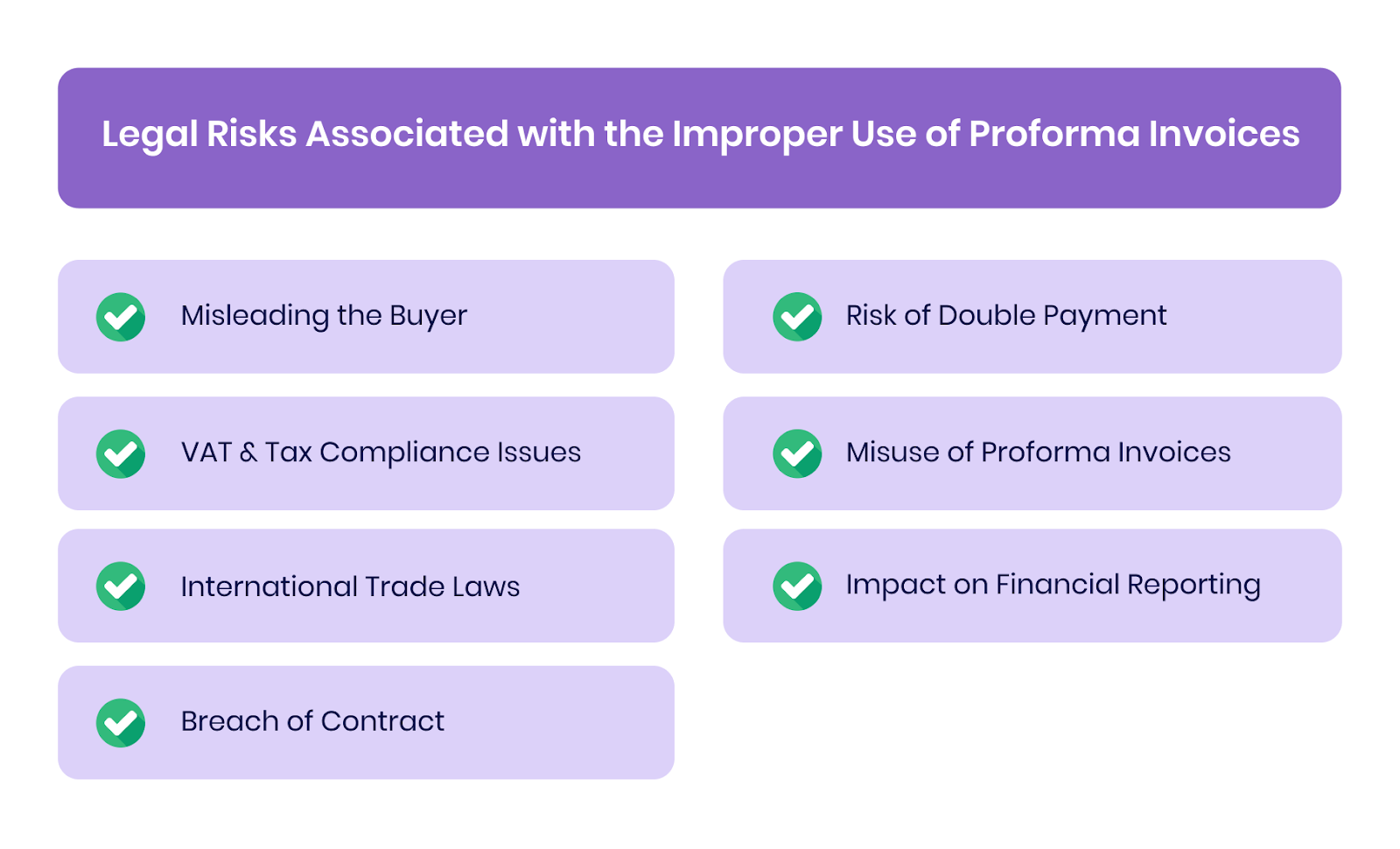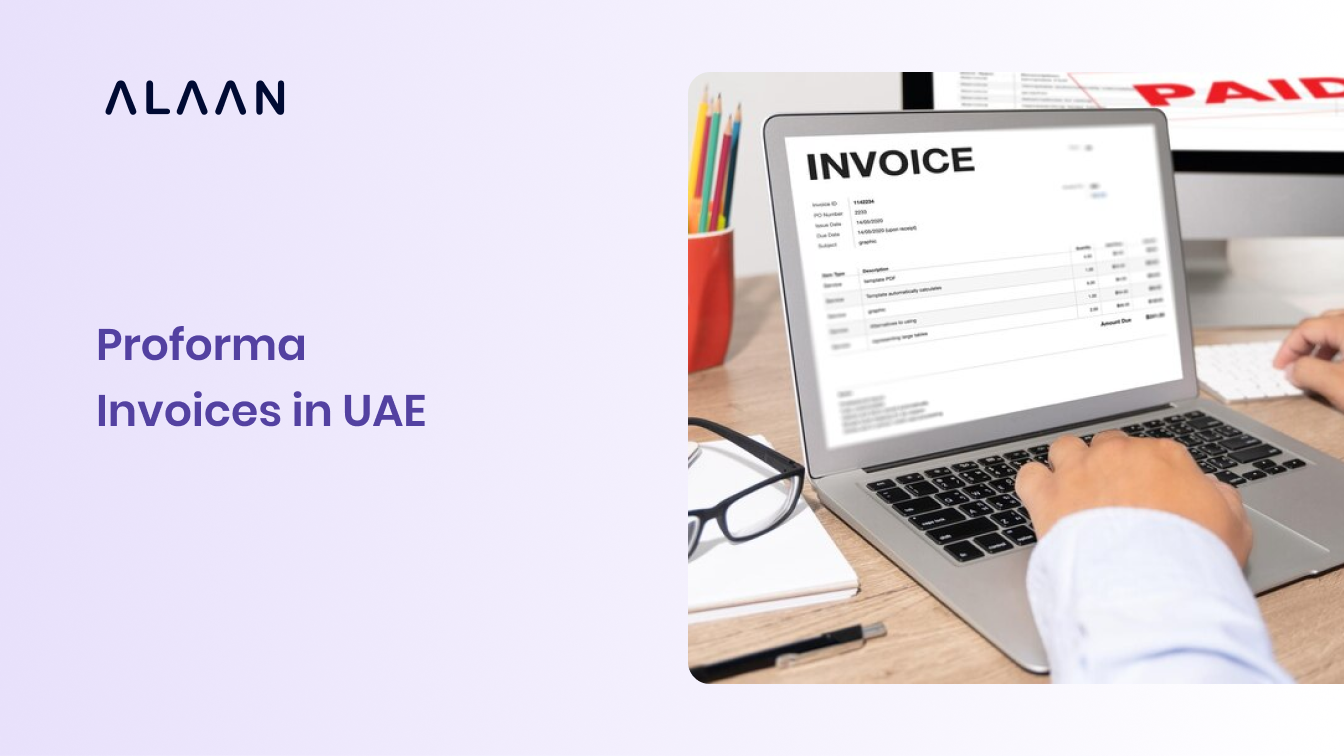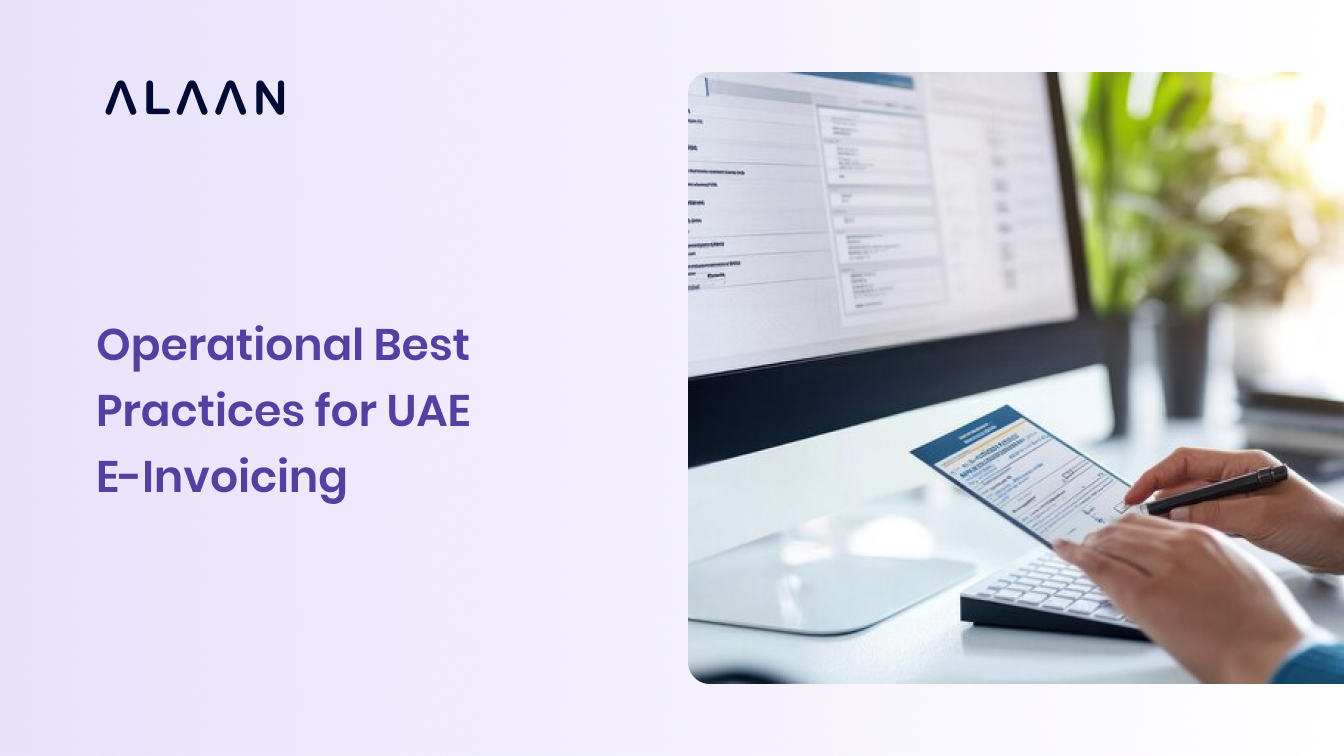In the UAE, bad debts now average about 8% of overdue invoices, and many of these cases aren’t caused by non-payment, but by misunderstandings at the deal stage. One common yet overlooked reason is the misuse of proforma invoices.
While proforma invoices don’t request payment, they carry more weight than most businesses realise. In the UAE, they directly impact VAT accuracy, customs clearance, liquidity planning, and even dispute prevention.
A poorly drafted or incorrectly labelled proforma invoice can lead to FTA penalties, customs delays, or contractual issues, turning a simple estimate into a serious compliance risk.
This guide explores why proforma invoices matter for UAE businesses. From understanding legal risks to aligning with VAT requirements and adopting best practices, you’ll see how proforma invoices can become a powerful tool for financial clarity, quicker cash flow, and smoother compliance.
Key Takeaways
- Creating a Proforma Invoice - Add seller and buyer details, assign a unique number, list goods or services with pricing, and include terms, taxes, and expiry clearly.
- Legal Risks of Misuse - Treating proforma invoices as final bills can cause disputes, VAT errors, customs delays, or even fraud-related penalties.
- Business Benefits of Proforma Invoices - Helps set clear expectations, improves cash flow planning, supports negotiations, and reduces chances of disputes.
- Compliance Obligations in UAE - Ensure VAT accuracy, proper TRN display, customs documentation, and clear consumer terms to meet legal requirements.
- Best Practices for Businesses - Label documents correctly, automate VAT calculations, keep proper records, and use invoicing software for accuracy.
How to Create a Proforma Invoice?
Creating a proforma invoice is usually a simple process, but it does call for careful attention to detail. The goal is to provide a clear cost estimate and set the right expectations for both the buyer and the seller before the transaction moves forward.
Here’s a step-by-step guide to creating a proforma invoice:
1. Add Seller and Buyer Information
- Seller’s Details: Begin with your business information, like company name, address, contact details, and VAT registration number (if applicable).
- Buyer’s Details: Next, include the buyer’s company name, address, and VAT registration number (if applicable).
2. Assign a Unique Invoice Number
Give the proforma invoice a unique number for easy tracking. This makes it simple to reference the transaction later, particularly when issuing the final invoice. Ideally, invoice numbers should be sequential and follow a format that helps keep your records organised.
3. Add the Date of Issue
Include the date when the proforma invoice is generated. This helps both parties track the timeline and lets the buyer know how long the offer is valid.
4. List the Goods or Services
- Item Description: Clearly describe the goods or services, including quantity, unit price, and total price.
- Part Numbers or SKUs (if applicable): Add product codes or identifiers to avoid confusion.
- Total Cost: Present the subtotal before taxes.
5. Specify the Terms of Sale
- Payment Terms: Outline how and when payments should be made (e.g., deposit required, balance due on delivery, or payment within 30 days).
- Delivery Terms: Mention the expected delivery date or service timeline.
- Shipping Details: If applicable, clarify who covers shipping costs and the delivery method (e.g., FOB, CIF).
6. Include Taxes and VAT Information
- VAT and Taxes: Add estimated VAT or other taxes. For UAE businesses, make sure the VAT calculation aligns with Federal Tax Authority (FTA) standards.
- Tax Registration Number (TRN): If VAT-registered, include your TRN for compliance.
7. Set an Expiry Date
State how long the proforma invoice is valid. Since prices and terms may change over time, specifying an expiry date makes expectations clear for both sides.
8. Add Custom Terms and Conditions
Include any specific conditions such as warranties, return policies, or delivery instructions. You can also add payment notes or details about handling disputes. This reduces the chance of misunderstandings and ensures both parties agree on finer details.
9. Review and Finalise
Before sending, carefully review the invoice for accuracy. Double-check calculations, tax details, and terms to ensure everything matches the agreed transaction.
10. Send the Proforma Invoice
Once finalised, share the proforma invoice with the buyer, usually by email. Use a clear subject line like “Proforma Invoice for [Transaction/Project Name]” and attach the document. It’s also helpful to let the buyer know you’re available for any questions.
After preparing the invoice, presenting it to clients professionally ensures clarity and encourages prompt acknowledgement or action.
Sample Email Template for Proforma Invoice
When sending a proforma invoice to a client, professionalism and clarity are key. Here’s a sample email template you can utilise when sharing a proforma invoice with a buyer:
Subject: Proforma Invoice for [Transaction/Project Name] - [Invoice Number]
Dear [Client’s Name],
I hope this message finds you well.
Please find attached the proforma invoice for [description of goods/services] related to [transaction/project name]. This document includes the estimated costs, payment terms, and delivery schedule for your reference. Kindly review the key details below:
- Total Estimated Amount: [Total amount]
- Payment Terms: [Deposit amount or full payment required]
- Due Date for Payment: [Date]
- VAT: [Applicable VAT amount, FTA-compliant]
This proforma invoice remains valid until [expiry date]. If you have any queries or require adjustments, please feel free to reach out.
To proceed, we kindly request [deposit/full payment] by [payment due date]. Payment can be made through [bank transfer, cheque, or online payment methods], using the details provided below:
[Insert payment details or bank account information]
Once payment is received, we can move forward with [shipping/delivery/completion of services] as per the agreed terms.
Thank you for your prompt attention, and we look forward to continuing our partnership. Please don’t hesitate to contact me if you need further assistance.
Best regards,
[Your Name]
[Your Position]
[Company Name]
[Contact Information]
[TRN if applicable]
Using proforma invoices effectively communicates costs. However, while proforma invoices offer benefits, be aware of the legal risks that can arise if they are not used correctly.
Also Read: B2B E-Invoicing: Global System and Mandates
Legal Risks Associated with the Improper Use of Proforma Invoices

While proforma invoices are widely used in business transactions as a way to share cost estimates and pre-sale details, misusing them can create serious legal challenges. That’s why businesses need to understand the risks and use proforma invoices carefully.
Here are some of the main legal risks linked to the improper use of proforma invoices:
1. Misleading the Buyer
A proforma invoice is meant to act as an estimate, not a demand for payment. However, when it’s mistakenly presented as a final invoice, it can mislead the buyer. This creates risks such as:
- Disputes: The buyer may feel pressured into paying before final terms are agreed upon.
- Reputation Damage: Misleading customers erodes trust and may even lead to legal claims for misrepresentation.
To avoid this, always label the document clearly as a proforma invoice and never present it as a final bill.
2. VAT and Tax Compliance Issues
In the UAE, where VAT is closely regulated, mistakes with proforma invoices can create compliance problems, such as:
- Incorrect VAT Reporting: Since proforma invoices often show estimated VAT, errors in calculation or documentation can cause discrepancies in tax filings.
- Audit Risks: Misuse of proforma invoices can invite audits, fines, or even penalties from the Federal Tax Authority (FTA).
To stay compliant, businesses should ensure VAT details are accurate and remember that proforma invoices are for estimation only, not final tax reporting.
3. Failure to Comply with International Trade Laws
Proforma invoices are often required for customs clearance in cross-border trade. If they’re incomplete or inaccurate, businesses risk increases due to:
- Customs Delays or Fines: Incorrect values or product descriptions can result in delayed, fined, or confiscated goods.
- Violation of Trade Rules: Misrepresentation on proforma invoices can result in penalties, sanctions, or legal action under international trade laws.
For smooth clearance, proforma invoices should always meet customs requirements and accurately reflect the transaction.
4. Breach of Contract
Since proforma invoices are usually issued before a contract is signed, confusing them with a binding agreement can create problems. This includes:
- Contractual Disputes: Buyers or sellers may wrongly assume the proforma invoice represents a final agreement.
- Legal Action: If either party treats it as binding and fails to follow its terms, it could lead to breach-of-contract claims.
To avoid this, both parties should be clear that a proforma invoice is a preliminary estimate, not a contract.
5. Risk of Double Payment
Without proper tracking, proforma invoices can create payment confusion. For example:
- A customer may accidentally pay twice if both a proforma and a final invoice are issued for the same transaction.
- Businesses might lose track of multiple proforma invoices issued for the same deal.
Such errors hurt customer trust and may also lead to disputes or legal claims. Proper documentation and payment tracking are essential to prevent this.
6. Fraud and Misuse of Proforma Invoices
Unfortunately, proforma invoices can also be exploited in fraudulent schemes. Risks include:
- False Claims: Issuing fake or inflated proforma invoices for goods or services that don’t exist.
- Severe Penalties: Fraudulent use can lead to heavy fines, license cancellations, or even criminal charges.
To safeguard against this, businesses should implement internal checks and only issue proforma invoices based on real transactions.
7. Impact on Financial Reporting
Treating proforma invoices as final sales can distort a company’s financial health. This leads to:
- Inaccurate Records: Including them as revenue leads to overstated income.
- Audit Concerns: Errors during audits can result in compliance issues and legal consequences.
The best practice is to track proforma invoices separately from final invoices and exclude them from official revenue reporting.
Understanding these risks helps businesses in the UAE take the necessary precautions and follow best practices to remain compliant.
Obligations and Recommendations for UAE Businesses
In the UAE, businesses need to understand the legal obligations and best practices surrounding proforma invoices, particularly in relation to VAT compliance and customs requirements.
While proforma invoices are not legally binding, they still carry weight in international trade, tax reporting, and customer relationships. Below is a breakdown of key obligations and practical recommendations to help UAE businesses stay compliant and efficient.
Obligations for UAE Businesses
It is important to understand the compliance requirements set by UAE laws and regulations. This includes:
VAT Compliance
Proforma invoices must reflect UAE VAT rules to avoid penalties or reporting errors. Key points include:
- VAT Registration: Businesses registered for VAT must apply the correct 5% rate.
- Tax Registration Number (TRN): Always include your TRN when VAT is charged.
- Accurate VAT Reporting: Even though a proforma invoice isn’t a final invoice, VAT details shown must be correct to prevent future discrepancies.
Customs and Trade Compliance
Customs authorities often rely on proforma invoices to assess goods in international trade. Businesses should ensure:
- Accurate Documentation: Include HS Codes, product descriptions, quantities, and estimated values.
- Correct Declarations: Errors or incomplete information can delay clearance, attract fines, or even cause goods to be held.
- Estimated Duties and Taxes: Providing a realistic cost estimate helps buyers prepare for total expenses.
Legal and Contractual Clarity
Since a proforma invoice is only an estimate, misusing it can create legal challenges. Businesses must:
- Avoid Misrepresentation: Clearly state that the document is not a demand for payment.
- Maintain Records: Keep organised copies of all proforma invoices for audits, tax filings, and internal checks.
Consumer Protection
UAE consumer protection laws require businesses to be transparent. This means:
- Accurate Pricing: Avoid hidden charges or misleading figures.
- Clear Terms: State payment conditions, delivery timelines, and other key terms to prevent disputes.
Following these obligations, practical recommendations guide businesses in simplifying proforma invoicing while reducing errors and risk.
Also Read: Step-by-Step Automated Invoice Processing and Its Benefits
Recommendations for UAE Businesses
Meeting compliance requirements is only part of the picture. Following best practices can make proforma invoices a useful tool for efficiency and trust-building. Below are the best practices:
- Double-Check VAT Calculations: Using invoicing software that applies VAT automatically can minimise errors and keep businesses compliant with Federal Tax Authority rules.
- Be Transparent with Payment Terms: Proforma invoices should outline deposits, payment methods, and timelines clearly, but avoid presenting them as final payment requests.
- Clearly Label the Document: Mark the invoice as “Proforma Invoice” and, if useful, add a short note to confirm it’s a cost estimate, not a demand for payment.
- Automate Where Possible: Adopting invoicing systems that integrate with accounting software (like QuickBooks, Xero, or NetSuite) ensures accurate details and saves time.
- Keep Proper Records: Digital storage of all proforma invoices and related correspondence can help during audits and prevent compliance issues.
- Upselling and Cross-Selling Opportunities: List related products or services alongside the main order and suggest complementary options to customers.
- Seek Expert Guidance for Complex Cases: For cross-border trade, exempt goods, or large-scale transactions, consulting a tax or legal expert ensures compliance with UAE VAT and customs regulations.
- Stay Updated on Regulations: Since VAT and customs rules can change, reviewing updates from the Federal Tax Authority regularly will help businesses stay ahead.
How Alaan Helps Simplify Proforma Invoice Management in the UAE?
In the UAE, businesses often face challenges with managing cost estimates, maintaining accurate records, and ensuring VAT compliance. At Alaan, we simplify the entire invoicing process. Here’s how Alaan makes proforma invoicing effortless:
- Automated Invoice Data Capture: Extract key details from receipts and invoices with Alaan’s AI-powered system, reducing manual data entry and making proforma invoicing faster and error-free.
- Real-Time Spend Tracking and Visibility: Monitor estimated costs across departments, projects, and cost centres. Alaan provides instant insights into expected expenses, enabling more accurate budgeting and forecasting.
- Integrated VAT Compliance and Workflow Automation: Automatically assign correct UAE VAT codes to transactions, ensuring compliance with FTA regulations. Alaan simplifies the creation of VAT-compliant proforma invoices and audit-ready records through automated workflows.
- Customisable Approval Workflows: Set up multi-level approvals and expense tracking to maintain accuracy and transparency before issuing any proforma invoices, reducing the risk of errors or disputes.
Connect with us to learn more.
Wrapping Up
Proforma invoices play a vital role for businesses in the UAE by providing a clear estimate of costs and terms before a transaction is finalised. They help reduce confusion, simplify customs procedures, and ensure VAT compliance, benefiting both buyers and sellers.
At Alaan, we recognise the value of accurate documentation and financial clarity. Our platform integrates smoothly with accounting software, enabling businesses to manage transactions and VAT compliance efficiently.
Book a quick demo today to see how Alaan can simplify your invoicing process, enhance VAT compliance, and optimise your financial operations smoothly.
FAQs
1. What is a Proforma Invoice?
A proforma invoice is a preliminary document that a seller shares with a buyer before the actual transaction happens. It works more like a detailed proposal, giving a clear estimate of the costs for goods or services.
2. What is the difference between a proforma invoice, an invoice, and a price quote?
A proforma invoice provides a detailed estimate before confirmation, an invoice requests payment after delivery, and a price quote offers an initial non-binding cost estimate.
3. Do I need to pay taxes on a Proforma Invoice?
No, taxes are not charged on a proforma invoice because it is only an estimate, not a final transaction. VAT and other taxes will apply once the sale is completed and a final invoice is issued.
4. When should I issue a Proforma Invoice in the UAE?
Issue a proforma invoice when providing a cost estimate for goods or services, particularly in international trade or when VAT compliance is needed for customs. It helps buyers understand costs before committing.
5. What information should be included in a Proforma Invoice?
Include seller and buyer details, description of goods/services, estimated costs, payment terms, delivery details, and applicable taxes. Clearly state that it is an estimate and not a final invoice.
6. Do I need a Proforma Invoice for international trade in the UAE?
Yes, proforma invoices are often required for customs clearance, helping determine the value of goods and calculate applicable taxes or duties for imports and exports.
7. How long can a Proforma Invoice be valid in the UAE?
Proforma invoices usually have an expiry date set by the seller, typically valid for a few weeks or months. After this period, terms may need to be revised.


.avif)







%201.png)